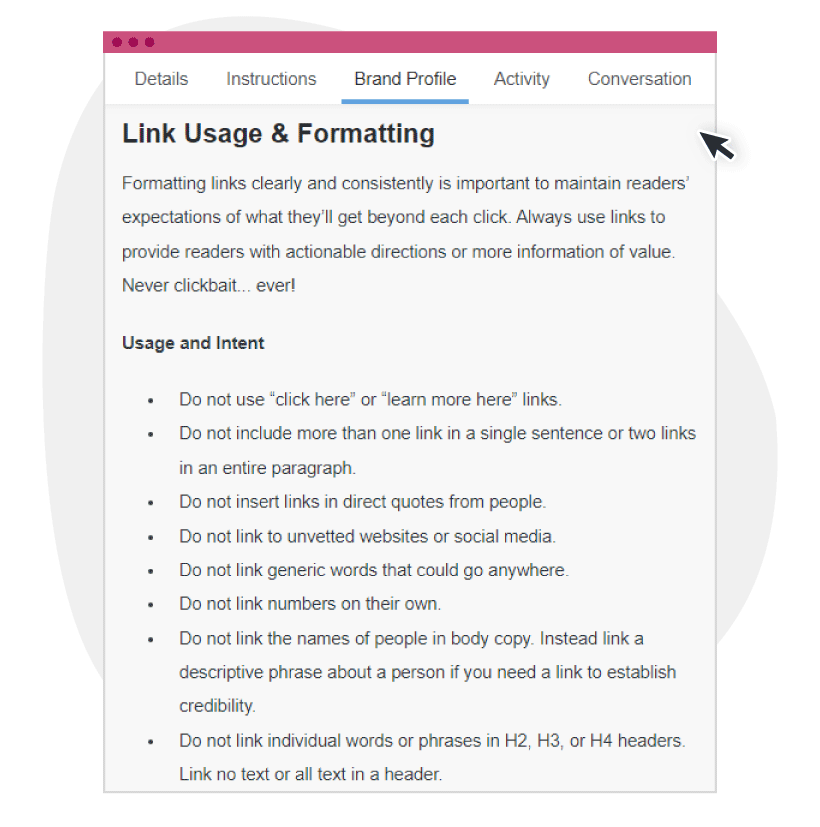A surprising 15% of businesses have no brand guidelines, and even worse, 77% create off-brand content.
If you want your brand to stick in people’s minds, it’s not enough that you’re producing content consistently. You have to produce on-brand content every time.
Consistency is the not-so-secret sauce to brand recall, and your branding guidelines serve as the playbook that keeps everything on track.
Comprehensive, user-friendly guidelines that document your branding and language preferences ensure every piece of content you create stays true to your brand’s voice and style, no matter who’s working on it.
In this guide, we take a look at:
- Why your content strategy needs brand and editorial guidelines
- Why SEO should be a part of your brand guidelines
- Some best practices for aligning brand guidelines with SEO
Why Brand and Editorial Guidelines Matter in Content Strategy
Let’s talk about the backbone of your content strategy — editorial and brand guidelines.
- Brand guidelines define who you are as a brand: Think of them like your brand’s signature style, complete with your logo, typography, color scheme, and tone of voice. They create a unified look and feel that makes your brand instantly recognizable, no matter where your audience encounters it.
- Editorial guidelines focus on the nitty-gritty of content creation: They cover everything from grammar to how your brand’s voice should come across in writing.
Together, these ensure that every piece of content is on point, whether you’re producing them in-house or you have a team of freelancers working on them.
The ClearVoice Brand Profile
At ClearVoice, branding, and editorial guidelines reside in a document called the “brand profile,” which is attached to every customer assignment. It’s a living, breathing document that can evolve over time or stay as is if updates are not needed.
We kick things off by collecting key branding and editorial information via a detailed intake form, followed by a discussion of the brand’s finer points. This deep dive enables the creation of a brand profile that serves as a blueprint for top-notch content.
With the brand profile in place, it’s easier for content creators to develop content that embodies the tone, style, and message the brand wants to be known for, whether that’s a blog post, a social media update, or an email. This way, you maintain a consistent brand presence across all platforms, even when multiple people are involved in the content creation process.
Why SEO Needs to Be in Your Brand Guidelines
“Build it, and they will come” is a marketing myth that has long been exposed for what it truly is — a myth. Even if your content solves problems, it won’t do much good if no one can find it.
That’s where search engine optimization comes in. You might be thinking, “Is SEO still a thing with all this AI stuff?” Yes, very much so. SEO may always be evolving, but it isn’t going away any time soon. “It’s immortal,” as one industry veteran puts it. And if there’s one thing SEOs are truly good at, it’s rolling with the punches.
Search engines assess content based on factors like quality, relevance, and user engagement. Content that follows SEO best practices tends to perform better because it’s designed for human readers and search engines.
Key on-page SEO elements like keywords, meta descriptions, and headings help people find your content:
- Keywords: Help search engines figure out what your content is about so it’s easier to match it with relevant searches.
- Meta descriptions: Provide a quick snapshot of your content, which can encourage users to click on your link in the search results.
- Properly structured headings: Make content easier to read, and help search engines understand the hierarchy and importance of the different sections within your content.
Integrating SEO into your brand guidelines
Including SEO in your brand guidelines helps keep things consistent while ensuring your content is search-friendly. Essential SEO elements you’ll want to include:
- Keyword usage: Specify which keywords to target and how they should be used throughout the content. For example, where to place them in headings, subheadings, and body text — and how often to use them.
- Content structure: Outline your preferred content structure, like using H2s and H3s to organize sections. Not only does this make content easier to read, but search engines can also more effectively crawl and index your content.
- Linking strategies: Include guidelines on internal and external linking. Internal links guide users to related content on your website, while external links to reputable sources can boost your content’s credibility. Linking to trusted sites signals to users that you’ve done your research. Search engines, meanwhile, view content with quality external links as more valuable.
For ClearVoice’s own brand profile, we typically include SEO guidelines on link usage and formatting (as shown in the screenshot below), including which competitor websites to avoid linking to and the types of anchor texts to use. You can also include any additional SEO-related instructions specific to your brand, such as target audience considerations and preferred keyword density (some brands put more emphasis on SEO, while others prefer a more natural tone).
The benefit of SEO in non-SEO content
Certain types of content aren’t made specifically for SEO, like newsletters, social media posts, or press releases. But it’s still a good idea to consider SEO when crafting them. That’s because SEO isn’t just about search engine rankings; it’s also about making your content more relevant and easier to find, no matter where it’s shared.
For example, using keywords naturally can help your content surface in search results, even if that wasn’t the primary goal, like in the case of press releases or social media content. Well-crafted meta descriptions or social media snippets can increase click-through rates, while SEO-optimized headlines and clear, structured formatting make your content easier to consume, whether it’s on a website, in an email, or on social media.
SEO and Brand Alignment: Best Practices
Aligning brand guidelines with SEO is all about striking the right balance between your brand’s voice and ensuring your content is searchable. Some best practices to consider:
Stay true to your brand voice
Sticking to your brand voice isn’t up for debate. Whether quirky, professional or somewhere in between, it’s non-negotiable.
The good thing is that SEO doesn’t have to cramp your style. You can still weave in keywords naturally without sounding like a robot. Or a broken record, for that matter. The key is to incorporate keywords and target phrases in a way that enhances rather than detracts from your message.
Prioritize user experience
The days of keyword stuffing are long gone. SEO today is primarily about delivering great user experiences, and that’s exactly what your brand and editorial guidelines are meant to do — keep visitors on the page for as long as possible. When they stick around longer because they like what they’re reading, the search engines take notice.
Ensure consistent messaging across platforms
The same keywords and phrases you use on your website should show up in your social media, email campaigns, and other content. This not only strengthens your brand’s presence but also helps search engines recognize you as an authority on those topics.
Approach SEO as a creative challenge
Think of SEO not as a set of rigid rules but as a creative challenge. How can you incorporate essential keywords while still keeping your brand’s personality intact? This will likely involve some brainstorming, testing, and tweaking, but it’s doable. Plus, when you get it right, you’re not just driving traffic — you’re bringing in the right kind of traffic, the kind that’s more likely to convert because they “get” you.
Monitor and adapt
SEO trends change, and your brand will likely evolve, too. Regularly review your content to ensure it’s still aligned with your brand guidelines and the latest SEO practices.
Branding Guidelines + SEO: The Winning Combination
At ClearVoice, we’re all about helping you create high-converting content your audience will love — and can actually find.
By embedding SEO directly into the brand profile, ClearVoice ensures that every piece of content, regardless of who creates it, aligns with the brand’s identity and SEO objectives. Writers and content creators have a clear roadmap to follow, so content is not only on-brand but also optimized for search visibility.
Need help creating search-friendly content that resonates with your audience? Connect with a ClearVoice specialist today.









